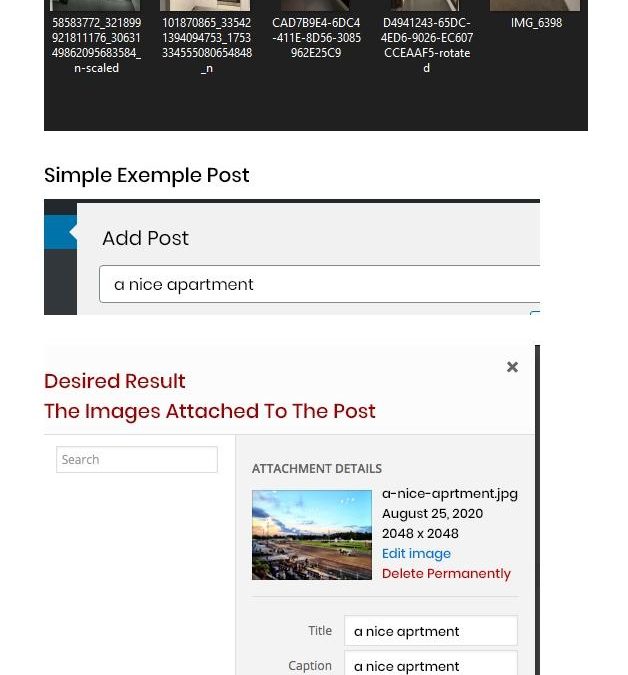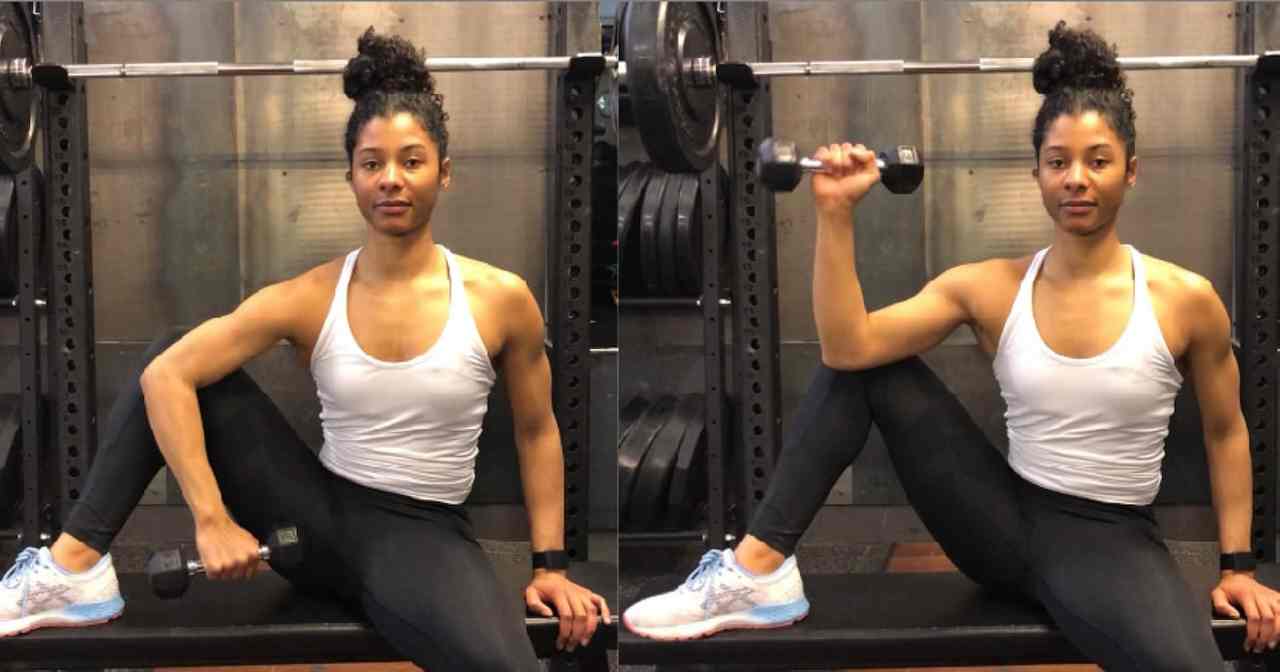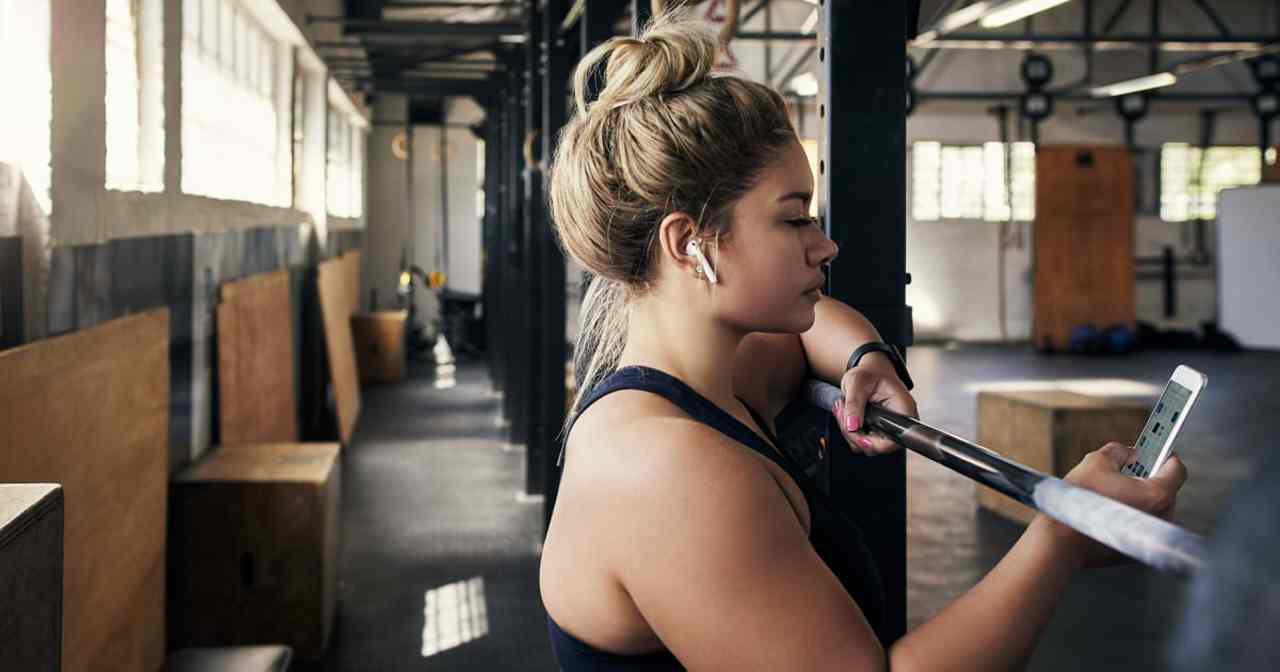
Just like you shouldn’t succumb to the too-good-to-be-true promise of “a lemon water a day will boost your metabolism” and other such wellness myths, you shouldn’t believe everything you hear in the fitness sphere either. Lead with scepticism before you do your own research or talk to experts (and certified experts at that). Not everything’s black and white, and not everything you read online is true. We’ve reported on fitness myths in the past, but this time around we wanted to do more digging, especially on myths that have persisted through the decade. POPSUGAR spoke to a handful of trainers and fitness experts on what they thought were the most common fitness myths in the last 10 years. Here are 15 of them, plus a bonus myth we just couldn’t leave out.
1
Myth: Running Will Make You Have Bad Knees
Image Source: Getty / PeopleImages
Becs Gentry, Peloton Tread instructor and RRCA-certified run coach, asked POPSUGAR, “How many millions of times do you hear people say, ‘Oh, you’re not going to be able to walk when you’re old’?” That running is bad for your knees has actually, she noted, been debunked in recent years. “There’s research proving that cardiovascular exercise including running can actually strengthen the bones and therefore leads to stronger joints and bones and helps people who have this so-called ‘bad knee issue.'” Note: some doctors do not recommend running for people with certain types of arthritis, so make sure to contact a medical professional.
Though “runner’s knee” can be caused by overuse, it doesn’t mean you’re going to be permanently injured, and there’s a difference between soreness and being in pain to the point where you need a break, Becs said. Plus, if you’re new to running, it’s normal to have aches, she added. “You have to look after everything in your body that hasn’t been moving like that before. You have to identify and accept that you have weaknesses in areas that you felt were quite strong like your knees, your hips, your back,” she noted. That being said, Becs advised that you should go to a physician if you’re experiencing runner’s knee or any other pain that worsens. Read more about runner’s knee here. In addition, make sure you’re wearing the proper shoes.
1 / 16
2
Myth: Runners Don’t Have to Do Upper-Body Strength Training
Image Source: Getty / sanjeri
Becs said that a lot of people think that runners don’t need to do upper-body strength training because you aren’t using that part of your body during runs. “They think it’s just the legs that work,” she said, but that’s not true. “You’ll see a lot of good runners spend a lot of time in the gym working on cables. They work on their posterior chain, on their back, because you need a very strong upper back in order to hold your shoulders in that great open position and drive your arms for extended periods of time.” She added that when your legs get tired, having a good arm swing will help you keep moving forward. Check out this total-body strength workout for runners.
2 / 16
3
Myth: Lifting Heavy Will Always Get You Toned Quicker
Image Source: Getty / South_agency
Becs also said that people think picking up the heaviest weights they “can possibly bicep curl” will get them toned arms quicker than “just doing reasonable weight.” Heavier weights do not necessarily lead to quicker muscle tone because, she said, you’re more likely to end up injuring your muscles trying to take on those loads that you can’t actually handle. Injured muscles equals inability to train as often.
When asked if she had tips for finding the best weight for toning muscles, Becs said, “You’re going to be looking to go into hypertrophy training, where you’re lifting about 10 to 12 repetitions of the weight for three to four sets. What you want to be able to do is complete every single one of those moves with control.” That means, you’re not letting the weight take your arm down or slamming it back to the floor, and you’re not using any other area of your body to move the weight, other than the muscle group you’re working on, she said.
For example, sometimes people will use their knees to pop up into a shoulder press when they’re tired, Becs explained. Lifting the right weight is still going to fatigue you by the third and fourth sets — “you’re obviously going to be tired,” she said — but you’re not “cheating” your way by using other parts of your body to lift the weight. Here’s more on how to choose the right weight.
Personal trainer Katie Crewe, CSCS, added that she’ll hear people say, “‘Oh, I’m lifting lighter weights because I want to tone. I don’t want to get bulky, so I’m not lifting heavy.'” But, she said, research shows that you can get similar muscle gains lifting lighter weights for more reps as opposed to heavier weights for fewer reps if you’re “still going within a couple of reps of failure because you’re still getting the same hypertrophic response.”
3 / 16
4
Myth: Lifting Weights Will Get You Bulky
Image Source: Getty / Mikolette
On that same note, Katie wanted to talk about the fact that getting “bulky” is extremely hard to do, and people shouldn’t be afraid of lifting weights. First of all, you need to eat enough protein and carbs to help repair your muscles and promote their growth. “The truth is, it just takes a really long time to make noticeable changes to your body,” she said. If you’re not eating in a surplus and lifting really hard to the point where you’re close to failure (that hypertrophy discussed earlier), as well as consistently increasing what you’re lifting and challenging yourself by implementing progressive overload, you’re “just not going to put on noticeable muscle” and bulk up.
4 / 16
5
Myth: Your Knees Can Never Pass Your Toes in a Squat
Image Source: Getty / South_agency
This is another myth Katie discussed. Based on old data showing that there was increased stress on your knees when you go past a certain depth, people have said that your knees should never go over your toes in squats. But, she said, nothing stated that the knees couldn’t tolerate that load. Plus, “The other thing is when people try really hard to not make their knees pass their toes, but they want to get to certain depth, they translate more stress to their lower back.”
Of course, if you have bad knees, don’t do a knee-dominant squat, Katie advised. But, “if you look at some of the best squatters in the world, like Olympic lifters, their knees go quite forward over their toes because they physically have to go that deep.” When you’re first starting out, your knees probably won’t go much past your toes anyway because you’re not going super deep into your squat, Katie said. But, when you get to a certain point, going into that depth is necessary for squatting. As long as you feel safe and comfortable when you’re squatting heavier weights, knees over toes isn’t a bad thing, she said. And, you still need to push your hips back like you’re sitting in a chair and keep your core engaged.
5 / 16
6
Myth: Just Working Out Will Make You Lose Fat
Image Source: Getty / Dougal Waters
Katie said that people often have a misconception that they can exercise and not change anything about their diet and, ultimately, they’ll lose weight. But, as we’ve reported on in the past (countless times, at that) unhealthy habits can still burden your weight-loss goals even if you’re working out. Some studies show that when people only incorporate training into their lives, the weight they lose isn’t very significant. It also could be that they “just get hungrier and eat back those calories,” Katie said.
In order to lose fat, you need to be in a caloric deficit and expend more calories than you’re eating. In fact, you could very well lose weight without exercise, though experts recommend that incorporating both is the most effective way to lose fat in general. Plus, it would be very difficult to create that caloric deficit just by working out and not focusing on diet. As Ashleigh Kast, NASM-certified trainer, told us in a previous interview, “the amount of working out you need to do in a week without addressing food to maintain that caloric deficit can be very stressful.” Here are seven fat-loss basics you should know.
6 / 16
7
Myth: Crunches and Sit-Ups Alone Will Give You Abs
Image Source: Getty / Sophie Invernesse
Courtney Roselle, NASM-certified personal trainer, certified functional strength coach, and founder of Iron Grace, told POPSUGAR that, when it comes to working your abs, you really need to focus on nutrition (speak to a dietitian about that specifically). Ultimately, you need a low enough percentage of body fat to see your abs and in order to do that, you need to be in a caloric deficit. Dietitians have also told us in past interviews that, when you’re looking to build your ab muscles and lose weight, you should be eating enough protein. Read more on food choices to promote weight-loss and ab visibility here.
You need to incorporate strength and weight training to build your core, Courtney said, because sit-ups alone won’t cut it. “It may come as a surprise, but the number one ab exercise I recommend is squatting. When you start to squat heavy, you fire up your core muscles to lift the weight and keep your body stable,” she said. “You should also incorporate flexion-extension movements like burpees and isometric holds like planks.” Check out more trainer exercise tips for abs here.
Related:
This 10-Minute Dance Workout Fuses Bollywood Choreography With Hip-Hop Moves
7 / 16
8
Myth: Cardio Is 100-Percent Necessary to Lose Fat
Image Source: Getty / Sorrasak Jar Tinyo
Courtney touched on the idea that cardio is the be all end all of weight loss. Truth? It’s not. “Weight training and resistance training can serve just as effective as cardio in losing weight,” she said. “When it comes down to losing weight, all it means is you need to burn more calories than you are eating. Intense weight training sessions and healthy eating can help you hit your goals.” Note: strength training builds muscle, and the more muscle you have, the more calories you will burn at rest.
That being said, you shouldn’t just strength train, but you also shouldn’t just do cardio. NASM-certified personal trainer Allison Tibbs explained that it’s a multi-pronged approach. Cardio, she said, “isn’t the saviour of fitness,” though it will help your cardiovascular health, which is important, and it will burn calories. At the same time, the value of strength training for weight loss has sometimes been overlooked, she said. And, it’s also about playing around with different types of cardio like high-intensity interval training (HIIT).
As exercise physiologist at NYU Langone’s Sports Performance Centre Rondel King, MS, CSCS, CES told POPSUGAR in a previous interview, “Having the cardio would definitely increase your cardiorespiratory fitness, and it’d just make you more functional in general.” Resistance training “would give you more muscle mass, and as a result, you will boost your metabolism and your resting energy expenditure.” Of course, everyone’s bodies are different and there’s no holy grail of weight loss that you necessarily have to stick to, but at the end of the day, you can’t just run on the treadmill for 45 minutes a few times a week and expect to see continued results.
8 / 16
9
Myth: “This 5-Minute Core Video Will Give You Rock-Hard Abs”
Image Source: Getty / domoyega
Oliver Lee, NASM-certified personal trainer, RRCA-certified run coach, and Peloton Tread instructor, talked about those videos that promise “five minutes to slimmer legs” or “10 minutes to rock-hard abs.” Time efficiency is great, he said, but the bottom line is that you need to be consistent and, of course, pay attention to what you’re eating. “You can definitely see results by doing, I’d say, a minimum of 20 minutes a day, five days a week and your diet is on point. But you’re not going to see a difference doing an eight-minute ab workout once a week and your diet staying the same.” Short videos can absolutely help contribute to your end goal; however, it’s not going not change you on the spot, he said. “It’s a bit more than just a magic wand.”
Oliver named HIIT as a time-efficient workout he’s a fan of (not to mention, it’s proven to promote fat loss). He continued, “If you’re short for time and you do a 10-minute HIIT where you put some Tabata rounds in there . . . 20 seconds on, 10 seconds off . . . you’re going to burn calories. But you’ve got to consider all the other stuff that goes with it like diet and then how often you’re going to do that 10-minute HIIT. Are you going to do it once a week, or are you going to do it five times a week?” Volume, frequency, and intensity are important factors, he said, meaning, for weightlifting, how much you’re lifting, how often you’re lifting, and at what intensity you’re lifting.
Allison agreed. She said workouts that promise you great results in a short amount of time are a “brilliant marketing tactic because our schedules aren’t getting lighter, we’re not getting more time in the day.” People want to get fit quick. Allison explained that there’s nothing wrong with trying to be efficient — and short workouts are better than no workouts — but if you want to see results, having a real program that’s tailored to your goals is key. Check out these tips for choosing an online fitness plan.
9 / 16
10
Myth: You Can Spot-Reduce Fat From Certain Parts of Your Body
Image Source: Getty / sanjeri
Another big myth that Oliver wanted to debunk was spot reduction, meaning the ability to eliminate fat from a specific part of your body by training that body part. If you’re trying to “shrink” your booty or eliminate belly fat, for example, you need to lose weight everywhere in order to do so.
Alex Harrison, PhD, CSCS, Sport Performance Coach for Renaissance Periodization and former exercise physiology professor at King College, told POPSUGAR that, if you have less fat in a certain area and you lose fat everywhere, that fat will be the first thing to go because you have less of it there in the first place. Makes sense, right? “Where you have less fat naturally, you’re going to lose it first, but where you have the most fat, you will lose it last.” Read more on why you can’t control where you lose fat.
“If you’re trying to grow muscle, you could probably target it a little bit more,” Oliver noted. For instance, if you want a bigger booty, doing “heavy hip thrusts, deadlifts, single-leg deadlifts,” and other exercises can help grow your glutes. They’ll also target your hamstrings, though, because you’re using more than one muscle group to do those moves. Oliver used an example of his friend who did 200 push-ups a day for a month. His chest got bigger, but so did his traps, his triceps, etc. And, like mentioned before, you have to do exercises with enough volume, intensity, and frequency for significant growth to happen.
10 / 16
11
Myth: Fasted Cardio Will Help You Lose Fat Faster
Image Source: Getty / zoranm
Alex wanted to talk about fasted cardio, meaning, doing cardio on an empty stomach and “forcing” the body to use fat as fuel as opposed to carbs. “No, fasted cardio is not going to help you lose fat faster if you’re a regular exerciser,” he said. It may benefit elite endurance athletes in the longterm, but generally, it’s not going to effect the majority of people.
Alex explained, “When you actually look at what happens over the course of six weeks, when you implement this plan where this person walks three days a week fasted in the morning, they’re not any different in body composition than somebody who ate before their workout.” Check out this study for more on the lack of evidence of body composition change. He continued that the body has ways to compensate for short-term fat burn in a fasted state. “If you happen to convince your body to burn a bunch of fat by walking fasted or doing cardio fasted, you convinced your body to burn a bunch of fats during that session. As soon as that session is over, and you go eat, your body figures out a way to replenish those fat stores,” he said.
There also may be some negative side effects of fasted cardio such as hypoglycemia, Alex said. “You can get hypoglycemia from fasted cardio simply because you’re burning through your sugar stores. If you eat right before training, that won’t happen, or if you eat a couple of hours before training, it also won’t happen.” It’s for that reason that he doesn’t recommend fasted cardio for regular people.
Alex explained, “One of the problems with getting even mildly hypoglycemic is you get super hungry. When people are super hungry, they overeat. If you want somebody to stick to a diet plan, unless we’re talking about highly regimented bodybuilder athletes, don’t risk giving them hypoglycemia by having them do fasted cardio.” And, some people point to the fact that fasted cardio could result in more protein burned, which negatively affects your muscle growth.
11 / 16
12
Myth: If You Stop Training, Your Progress Is Lost
Image Source: Getty / PeopleImages
Alex said that people often think that if they lose their momentum, take time away from their routines, and back track, they won’t be able to return to how they were. They think that it’s a “catastrophe and it’s going to take forever to get that back,” he told POPSUGAR. “It’s so not true, and I wish I could shout it from the rooftops.” The big part of that myth, he said, is that it takes the same amount of work as before to get back to there they were, and the reason why that’s not necessarily true is a bit complex, so listen up.
When you first train, you slowly grow muscles, and it’s a process that takes quite a bit of time, Alex said. If you spend a couple of years training hard and then stop, you can go to the gym and get those muscles back way more easily than you think. That’s because when you built muscles in the first place, “satellite cells donated their nuclei into the muscle cells to allow them to grow further. That donation of nuclei into the muscle cells is permanent. The nuclei never leave again,” Alex explained. “Even if you lose all your muscle size, you take 10 years off from training, have a family, all of that, those muscle cells still have those nuclei.”
He continued, “The nucleus is what produces all of the protein within the muscle to grow the muscle in the first place. It’s sort of like the hub of all growth, like an Amazon shipping centre. It’s the hub that everything goes out from. If you don’t have enough of those, you can’t grow your muscles any bigger.” If you stopped working out, you can lose muscle size quickly in the first month, Alex said. “The muscles look less full because you have less glycogen stored in them.” But, because of the nuclei still stored in your muscle cells, you’ll be able to build muscle much faster than someone who never trained before, he said.
12 / 16
13
Myth: Machines Are Better For Toning Muscles Than Free Weights
Image Source: Getty / SolStock
Kate Ligler, MINDBODY Wellness Manager and NASM-certified personal trainer, corrective exercise specialist, and performance enhancement specialist, told POPSUGAR that if you are somebody who is already very lean and you’re really looking to target your muscles more, a machine is going to be effective. But, she said, free weights will give you a full-body approach that machines won’t necessarily give.
Kate continued, “By and large, when it comes to toning, machines can miss that total-body component that using free weights will. For instance, a standing bicep curl also engages your core. . . . If you are somebody who is targeting weight loss, I would recommend a free weight over a machine any day of the week because you’re going to burn more calories and ultimately target more systems.”
13 / 16
14
Myth: Women Need Different Equipment Than Men
Image Source: Getty / mihailomilovanovic
Kate swears that the idea that women need different equipment is “just a clever marketing ploy. Our differences are in our bone structure and our differences are in our hormones, but functional movement patterns are for everybody.” And, she said, for example, a strong core is functionally going to benefit a man in the exact same ways that it’s going to benefit a woman. She knows that if a woman is working out next to a man who’s a foot taller than her, “his levers are a lot longer than hers and his capability for leverage and power will be very different than hers, but pound for pound, if you have a man and a woman who are almost identical, they will lift and do things almost identically.” She pointed to the CrossFit Games for proof, which she said have highlighted just how strong women can be.
Related:
This 30-Minute Barre Workout Is Designed to Help You Shake Off a Bad Day
14 / 16
15
Myth: You Have to Stretch Before Working Out
Image Source: Getty / Oscar Montilla
Kate also discussed the fact that, for a long time, stretching before workouts was encouraged. “This was the power of our middle school PE teacher that basically needed to kill 20 minutes of time everyday in gym class,” she recalled. (Boy, can I relate!) “You don’t prepare to move by not moving, which is all static stretching is. You go to a position and freeze.” Holding a static stretch before you start exercising can, as it turns out, negatively impact muscle strength and performance, she said, and you can actually harm muscles by overstretching.
If you’re about to go on the treadmill or StairMaster, she said, the easiest active warmup is walking. Preparing for high-intensity cardio simply requires you to elevate your heart rate beforehand. If you’re about to do some strength training, warm up the muscle groups you’re going to target in that workout. For instance, on leg day, Kate will have her clients do some light lunges. She also might have them warm up their legs by doing a light jog. Dynamic stretches where you incorporate movement are OK.
Static stretches after workouts, Kate said, are great. “Improving muscle flexibility, improving mobility in general, that’s something that should be done after your focussed work because you are warm and you reduce the risk of injury that could come from overstretching.”
15 / 16
16
Bonus Myth: Muscle Weighs More Than Fat
Image Source: Getty / svetikd
We couldn’t notinclude this one last myth. “Muscle weighs more than fat” is a common line that has been heard in the fitness community over the past years. In a preview interview, NASM-certified personal trainer Gabbi Berkow, MA, CDN, told POPSUGAR that a pound of muscle weighs the same as a pound of fat (a pound is a pound). But, muscle is denser than fat, she said. “It has more water, protein, carbohydrates, and fats in it than fat does, but it takes up less space. Since density equals weight divided by volume, the same amount or weight of muscle takes up less space than fat.” That’s why, she explained, gaining muscle is often associated with losing inches but not necessarily losing weight on the scale.
16 / 16











